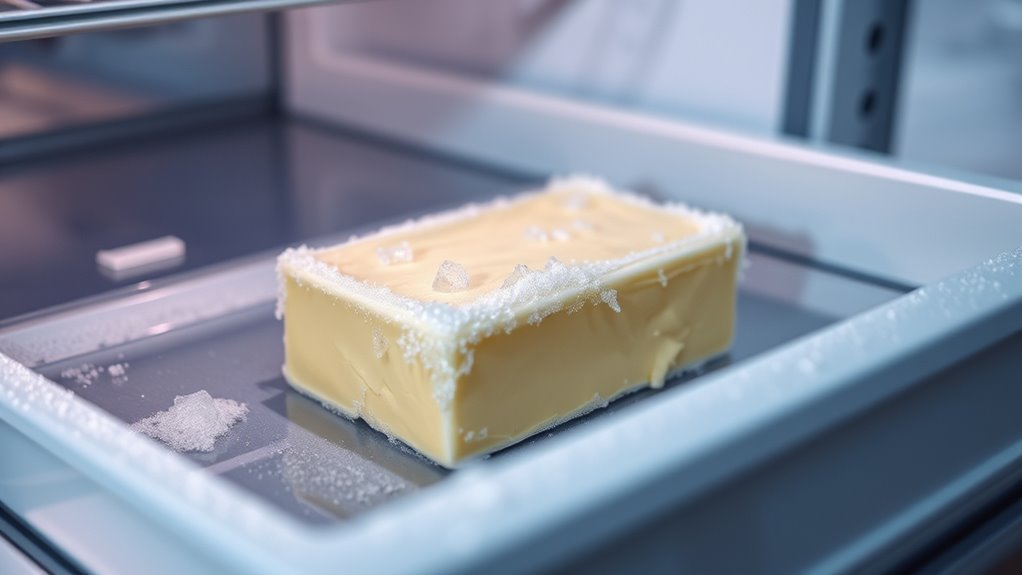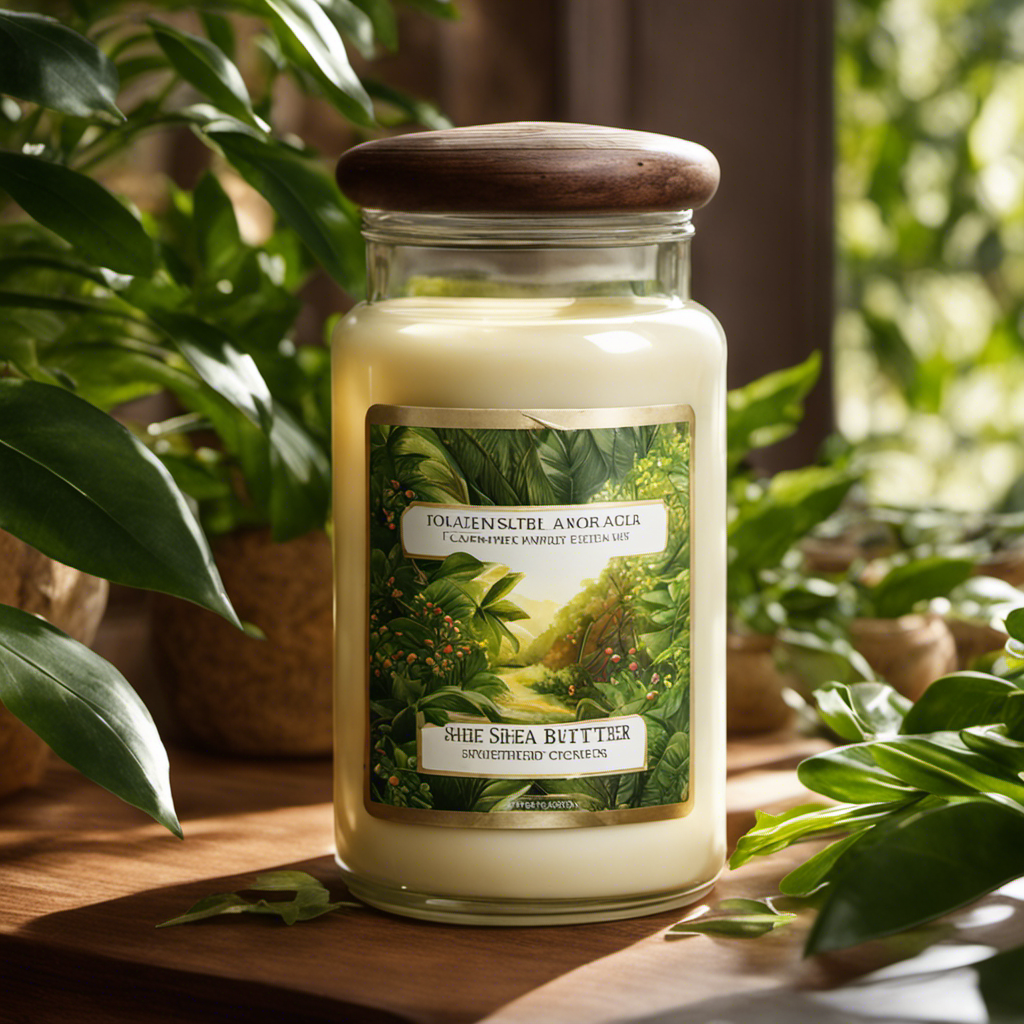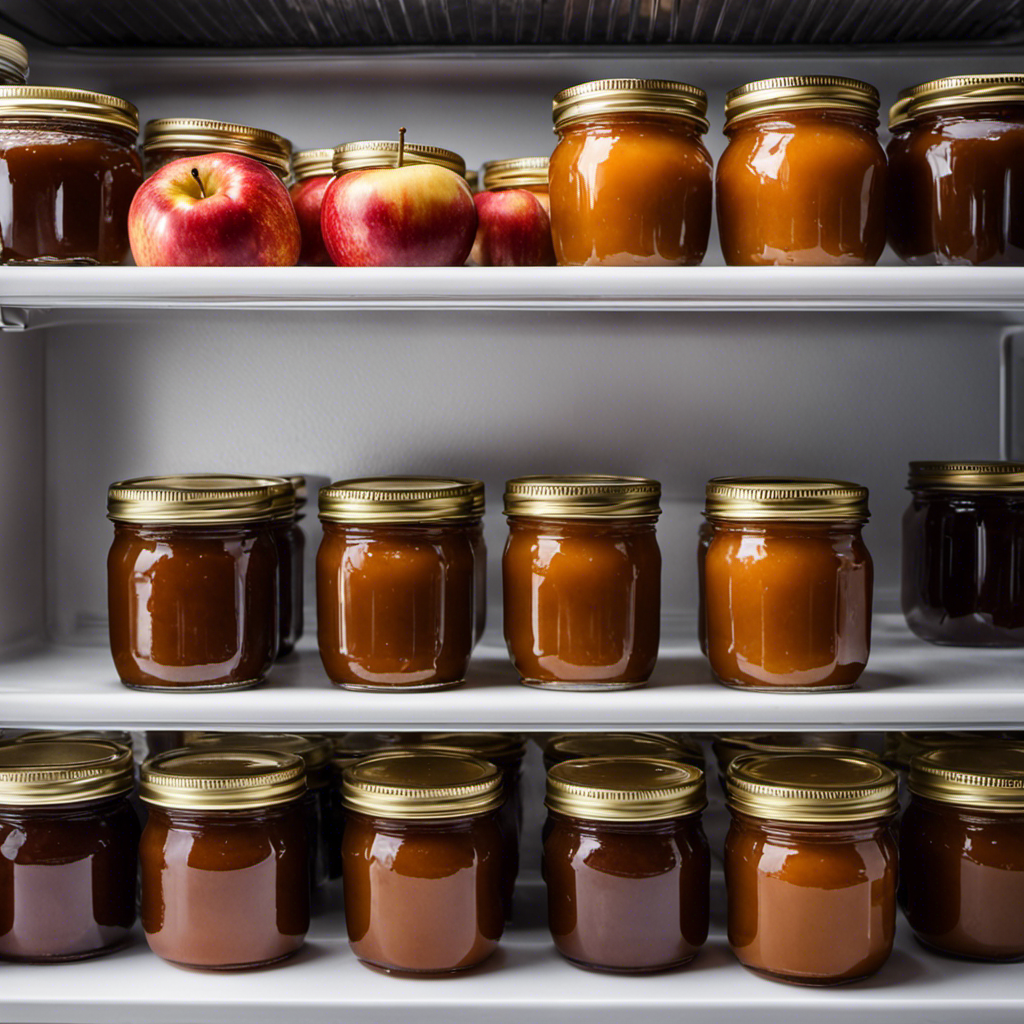Freezer burn on butter isn’t just caused by storage temperatures but mainly by improper packaging and temperature fluctuations, not a specific limit like 0°F. When butter is exposed to air or uneven temperatures, moisture escapes, leading to dry patches and flavor changes. Many myths suggest strict temperature rules, but consistent, cold storage with airtight packaging matters most. If you want to know how to keep butter fresh longer and prevent freezer burn effectively, keep exploring these tips.
Key Takeaways
- Freezer burn occurs mainly due to air exposure and temperature fluctuations, not just specific temperature limits.
- Maintaining a consistent temperature around 0°F (-18°C) minimizes ice crystal growth and prevents freezer burn.
- Myth: Butter can be stored at higher temperatures without quality loss; proper packaging and temperature control are more critical.
- Rapid freezing creates smaller ice crystals, reducing damage and preserving butter’s quality, regardless of the exact temperature.
- Proper airtight packaging and stable cold storage are essential to prevent freezer burn, not only the specific temperature setting.
Understanding Freezer Burn: What Really Happens to Butter
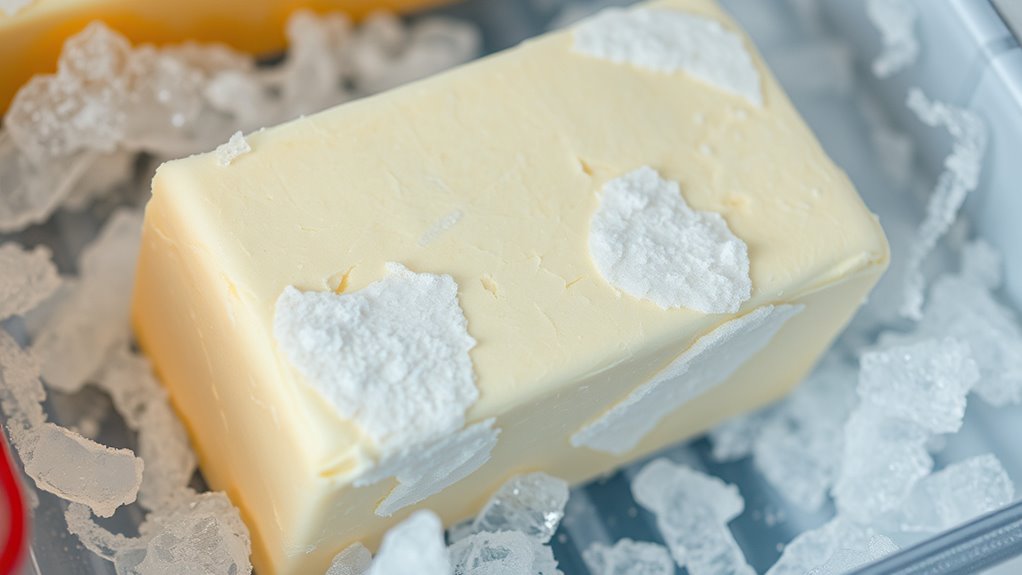
Freezer burn occurs when butter is exposed to air and fluctuating temperatures, causing it to lose moisture and develop dry, discolored patches. This process impacts the butter’s butter flavor, making it less appealing and altering its quality. Poor packaging materials, like thin or improperly sealed wraps, fail to protect butter from air exposure, accelerating freezer burn. When air reaches the butter, it causes dehydration and oxidation, which dulls its taste and texture. To prevent this, you should use airtight packaging designed for freezing, such as heavy-duty foil or vacuum-sealed bags. Proper packaging keeps out air and moisture, helping maintain the butter’s fresh flavor and preventing freezer burn from setting in. Understanding the role of packaging is key to preserving your butter’s quality over time. Additionally, using appropriate storage practices can further extend the butter’s shelf life and quality.
The Science of Freezing: Temperature and Ice Crystal Formation
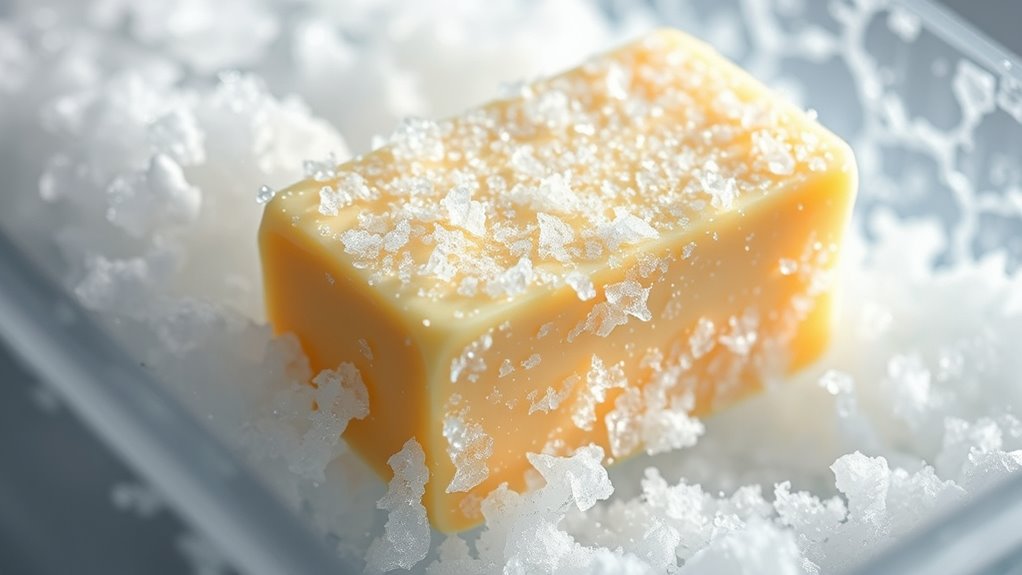
Understanding how temperature affects freezing is essential because it determines the size and formation of ice crystals within the butter. When you freeze butter quickly, the freezing rate is high, resulting in small ice crystals. These tiny crystals cause less damage to the butter’s structure, preserving texture and flavor. Conversely, a slow freezing rate allows larger ice crystals to form, which can puncture cell walls and lead to a grainy or crumbly texture when thawed. Temperature plays a key role here: colder temperatures speed up freezing, producing smaller crystals, while slightly higher temperatures slow the process, leading to larger crystals. By controlling freezing rate and maintaining proper temperature, you minimize ice crystal growth, keeping your butter fresher and more enjoyable over time. Freezing speed and temperature regulation are crucial factors in achieving optimal preservation results.
Common Myths About Butter Storage Temperatures
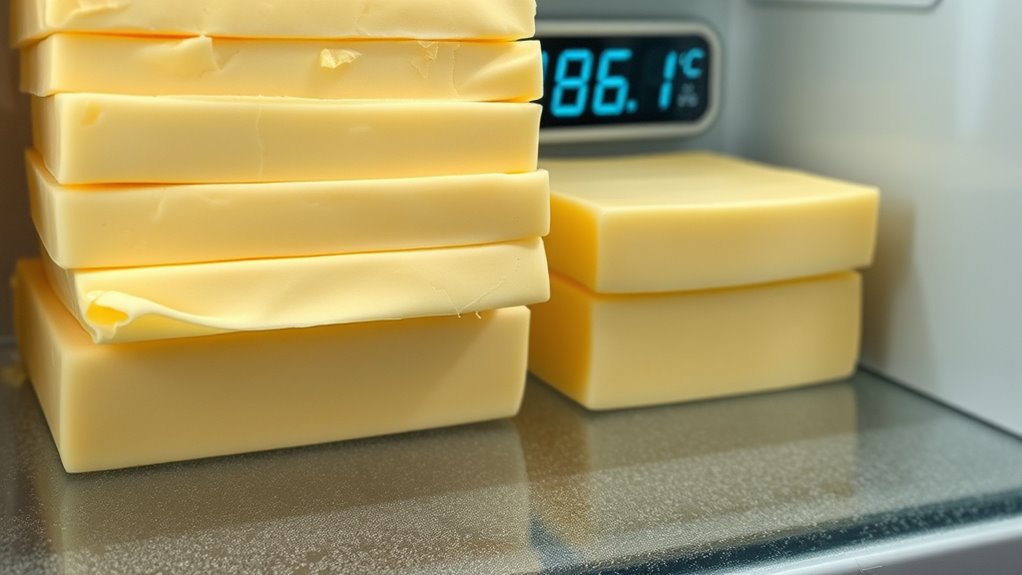
Many people believe that butter must be stored in the fridge at all times to stay fresh, but this is a common myth. Proper storage isn’t solely about temperature; it also involves maintaining butter’s flavor and quality. Storing butter at slightly higher temperatures, like in a butter dish or a cool pantry, can preserve its rich butter flavor without risking spoilage if used within a reasonable time. Packaging materials play a pivotal role in protecting butter from air and light, which can cause rancidity and off-flavors. Airtight containers or wrapping butter tightly minimizes exposure to oxygen and contaminants, regardless of whether it’s stored in the fridge or at room temperature. Additionally, understanding how creative practice can be applied to food storage solutions may help optimize butter preservation techniques.
How Temperature Affects Butter Quality Over Time
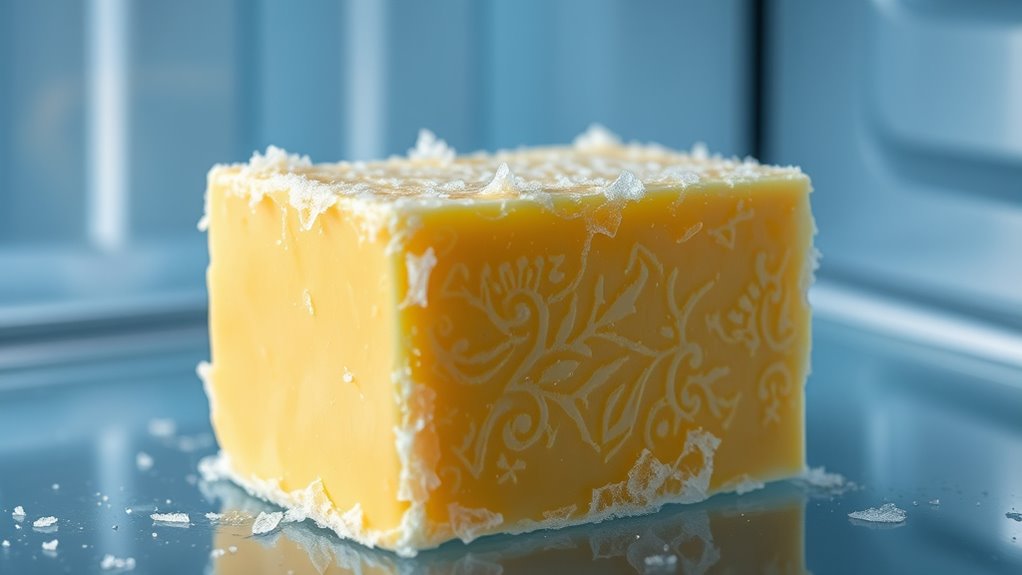
Temperature plays a significant role in how butter maintains its quality over time. When exposed to temperature fluctuations, butter can develop freezer burn or off-flavors, reducing its overall freshness. Consistent, cold storage helps preserve butter’s flavor and texture, preventing spoilage. Even minor changes in temperature can accelerate oxidation, causing butter to become rancid faster. Over time, higher temperatures promote moisture loss and cause fats to break down, negatively impacting butter flavor. Additionally, automation technologies in food storage and handling can improve temperature regulation and reduce spoilage risks. To keep butter at its best, avoid frequent temperature swings and store it in a sealed container in the coldest part of your fridge or freezer. Maintaining a stable temperature minimizes quality loss, ensuring your butter stays fresh, flavorful, and enjoyable for longer periods.
Optimal Freezing Practices for Butter Preservation
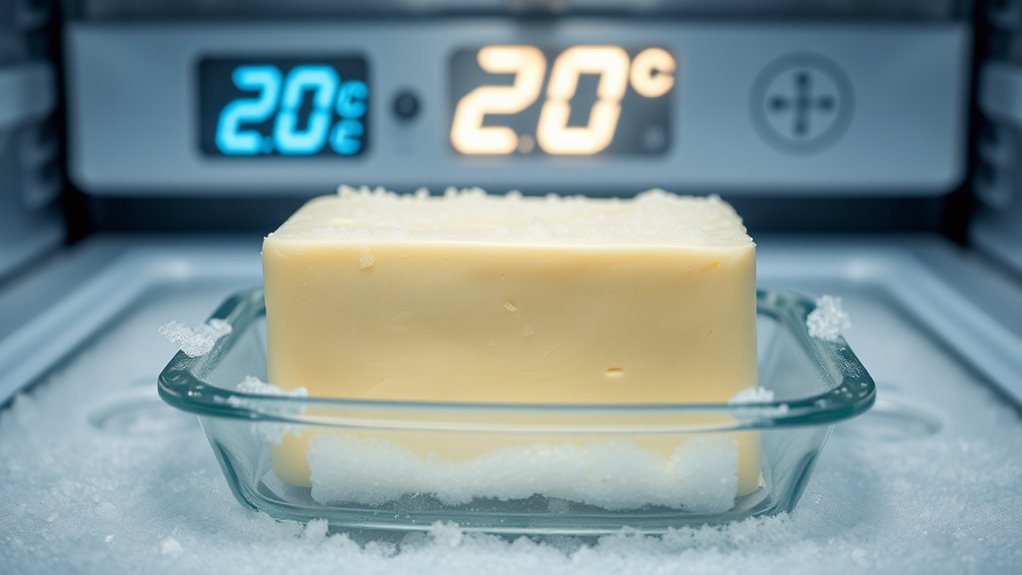
To keep your butter fresh, set your freezer to around 0°F (-18°C). Use airtight containers or wrap it tightly to prevent moisture and odor transfer. Following these steps helps preserve butter quality and minimize freezer burn. Additionally, regularly inspecting your freezer and updating your storage practices can help prevent freezer burn and maintain optimal quality.
Ideal Freezing Temperatures
Maintaining the ideal freezing temperature is crucial for preserving butter’s freshness and quality over time. The perfect temperature is around 0°F (-18°C), which slows down spoilage and prevents flavor degradation. When your freezer is consistently at this temperature, butter retains its rich butter flavor and smooth texture. Proper packaging considerations are essential; use airtight containers or heavy-duty foil to prevent moisture loss and protect against freezer burn. Avoid fluctuating temperatures, which can cause ice crystals to form and compromise the butter’s quality. Regularly check your freezer’s thermometer to ensure it stays at or below 0°F. By maintaining this temperature and using appropriate packaging, you help preserve the butter’s taste, texture, and overall quality for longer periods.
Proper Storage Techniques
Proper storage techniques are essential for keeping butter fresh and preventing freezer burn. To preserve butter flavor, always use airtight storage containers, which prevent air exposure and moisture loss. Wrap butter tightly in aluminum foil or plastic wrap before placing it in containers for extra protection. Avoid oversized containers that trap air; smaller portions reduce oxidation risks. Store butter at consistent freezing temperatures, ideally below 0°F (-18°C). Use the following table to select suitable storage options:
| Storage Method | Benefits |
|---|---|
| Airtight containers | Prevent freezer burn, lock flavor |
| Vacuum-sealed bags | Extend freshness, reduce odors |
| Foil and plastic wrap | Protects from moisture loss |
| Glass jars | Reusable, airtight, preserves flavor |
| Freezer-safe bags | Convenient, space-efficient |
Additionally, ensuring proper food safety practices can help maintain butter quality during freezing.
Identifying and Preventing Freezer Burn in Butter
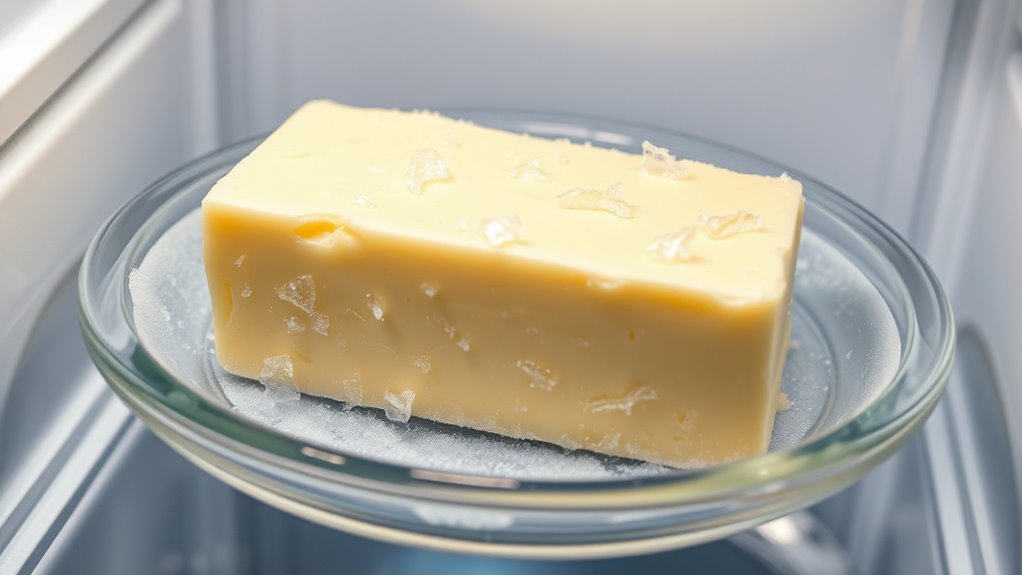
Freezer burn in butter often becomes noticeable when you see dry, discolored patches on its surface, indicating that moisture has been lost due to improper storage. These patches can affect both butter flavor and butter texture, making it less appealing. To identify freezer burn early, look for:
- White or grayish spots on the surface
- Dry, leathery patches that feel rough to the touch
- Changes in color, such as dull or faded areas
- A noticeable loss of aroma or a stale odor
Additionally, understanding how proper storage techniques help prevent freezer burn can prolong butter’s freshness and quality.
Practical Tips for Storing Butter Without Worry
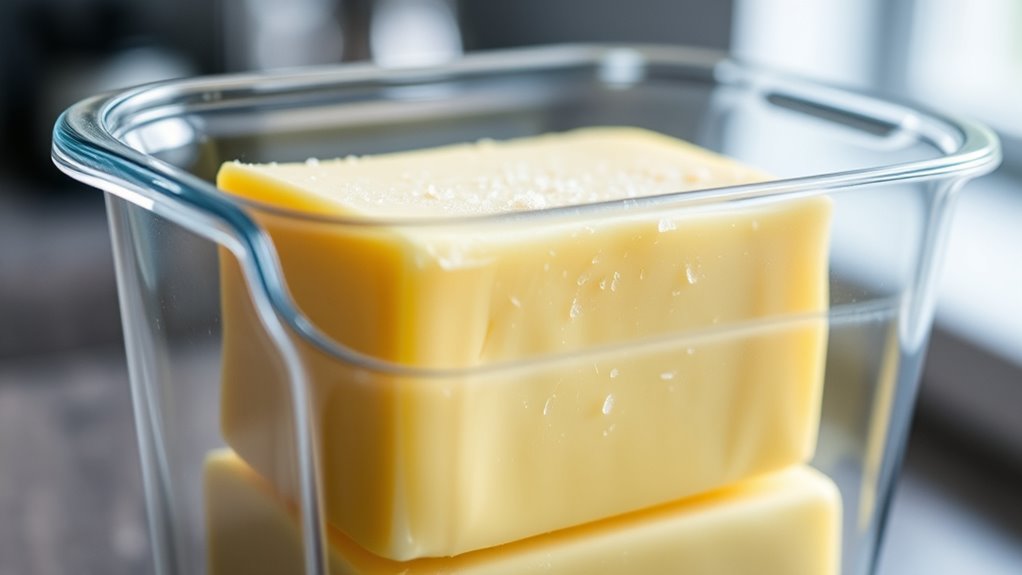
To keep your butter fresh and free from freezer burn, maintaining proper freezing techniques is crucial. Make sure to wrap it tightly and store it at the right temperature to prevent moisture loss. Paying attention to ideal storage conditions will help you preserve its quality longer.
Proper Freezing Techniques
When freezing butter, your goal should be to protect its flavor and texture by minimizing exposure to air and moisture. Proper butter packaging helps prevent freezer chaos and preserves quality. To do this effectively, consider these steps:
- Wrap the butter tightly in aluminum foil or plastic wrap to seal out air.
- Place the wrapped butter in an airtight container or resealable freezer bag.
- Label the package with the date to track freshness.
- Store the butter in the coldest part of your freezer, away from door openings.
These techniques help prevent flavor transfer, dehydration, and freezer burn. By focusing on good butter packaging and organized storage, you can enjoy fresh-tasting butter without worry, even after extended freezing periods.
Optimal Storage Conditions
Achieving ideal storage conditions for butter involves more than just proper packaging; it requires placing your butter in the right spot within your freezer. Store butter in airtight butter packaging or wrap it tightly in foil or plastic wrap to prevent air exposure. Use the coldest sections of your freezer, typically the back or bottom compartments, where temperature remains stable. Avoid freezer door compartments, which experience temperature fluctuations. For longer storage, consider dividing butter into smaller portions and wrapping each separately to reduce exposure to air and temperature changes. Label packages with dates to track freshness. Maintaining a consistent freezer temperature of 0°F (-18°C) helps prevent freezer burn and preserves butter’s quality. Proper placement and packaging are key to keeping your butter fresh and flavorful. Additionally, choosing a preppy dog name for your pet can add a touch of sophistication to your household.
Frequently Asked Questions
Can Butter Be Refrozen After It Has Developed Freezer Burn?
You might wonder if you can refreeze butter after freezer burn develops. While technically possible, it’s not recommended for freezer burn repair, as the butter’s texture will be compromised. Freezer burn affects the surface, causing dryness and off-flavors. Refreezing won’t restore its original quality, and the butter may become crumbly or greasy. For best results, store butter properly and avoid refreezing once freezer burn appears to maintain its texture and flavor.
How Does Packaging Influence Freezer Burn in Butter?
You should consider how packaging influences freezer burn in butter. Using airtight packaging and a strong moisture barrier helps prevent air exposure, which reduces freezer burn. When you store butter in such packaging, you limit moisture loss and protect it from humidity changes. This keeps your butter fresh longer and maintains its quality, so always opt for containers that seal tightly and block air to safeguard against freezer burn.
Is It Safe to Consume Butter With Freezer Burn?
You might wonder if butter with freezer burn is safe to eat. Yes, it is safe; freezer burn only affects the butter’s flavor and texture due to moisture loss. The butter may taste stale or have a dry texture, but it won’t harm you. To enjoy the best flavor, consider trimming away the affected areas, but consuming freezer-burned butter won’t pose any health risks.
What Are the Signs That Butter Has Gone Bad Beyond Freezer Burn?
Think of butter as a trusted friend whose appearance and scent reveal its health. If you notice an odor change or discoloration, it’s like discovering a friend’s mood has shifted—something’s off. These signs indicate spoilage beyond freezer burn. Stay alert for sour smell, mold, or a slimy texture. If any of these appear, it’s time to say goodbye, and find a fresh companion for your baking or spreading needs.
How Long Can Butter Be Stored in the Freezer Without Quality Loss?
You can store butter in the freezer for up to six to nine months without significant quality loss. During this storage duration, the butter’s flavor remains mostly intact, and it stays fresh. To maximize shelf life, wrap it tightly or place it in an airtight container. Keep in mind that after this period, the butter may begin to lose its fresh butter flavor and develop freezer burn, impacting its overall quality.
Conclusion
Think of your butter as a delicate sculpture, easily marred by the chill of freezer burn. By understanding the science behind freezing temperatures and following best storage practices, you can preserve its buttery richness like a treasured masterpiece. Don’t let myths cloud your judgment—trust the facts, and keep your butter fresh and flavorful, much like a secret kept safe in a locked vault, waiting to be enjoyed at just the right moment.
